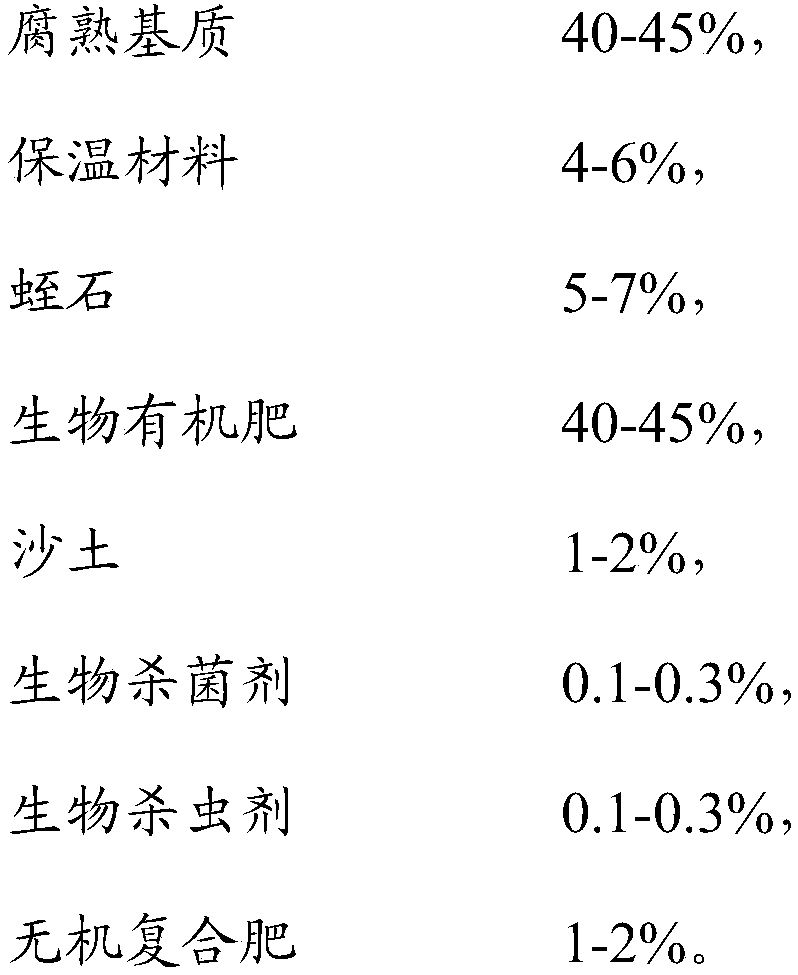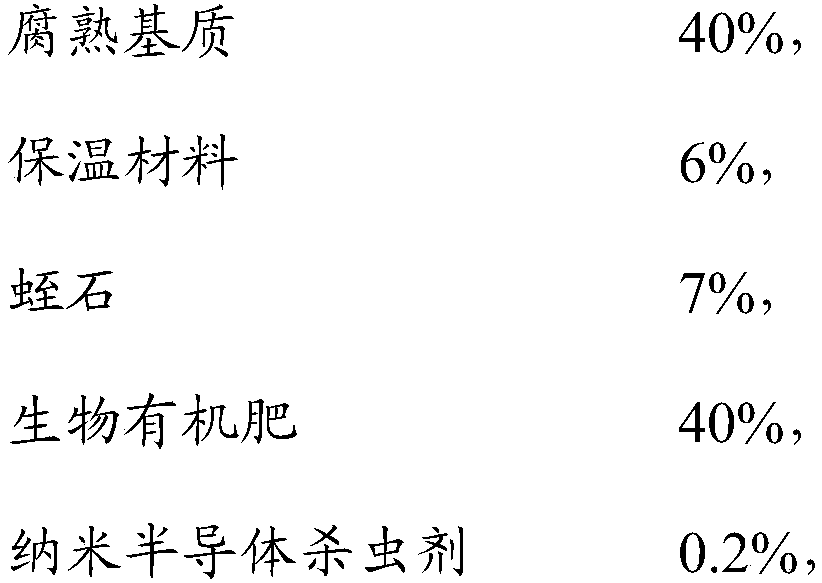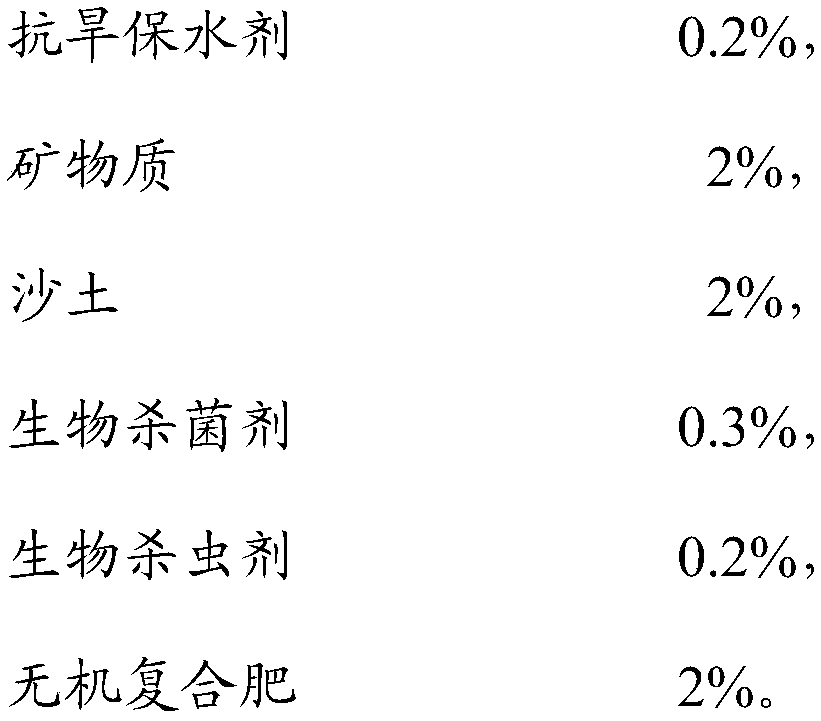Disease-resistant and insect-resistant organic vegetable planting medium
A technology of organic vegetables and substrates, which is applied in the field of disease-resistant and insect-resistant organic vegetable substrates, can solve the problems of poor water retention and air permeability, poor buffering performance, affecting crop growth, and pollution-free quality, and achieves saving watering time, wide applicability, and release good water performance
- Summary
- Abstract
- Description
- Claims
- Application Information
AI Technical Summary
Problems solved by technology
Method used
Image
Examples
Embodiment 1
[0079] Potted lettuce, plastic pot 45cm×25cm×12cm, with a hole of 2cm in diameter at the bottom of the pot, and a height of 10cm for the substrate.
[0080] 1. Matrix and indicators
[0081] 1. Matrix formula:
[0082]40% decomposed substrate, 6% perlite, 7% vermiculite, 40% bio-organic fertilizer, 0.2% nano-semiconductor insecticide, 0.2% acrylic acid-polyethylene glycol diacrylate copolymer, diatomaceous earth, weathered coal powder The mixture is composed of 2% of bentonite, 2% of sandy soil, 0.3% of bacillus subtilis, 0.3% of reedrine and 15-15-152% of compound fertilizer.
[0083] Among them, chicken manure, corn stalks, and sawdust are used as raw materials for the decomposed substrate, which are obtained after drying, mixing, stacking and fermentation for 15 days; the weight ratio of diatomite, weathered coal powder and bentonite is 1:1.2:3.
[0084] 2. The indicators of lettuce substrate are as follows:
[0085] Particle size: 3mm; Bulk density: 0.7g / cm3; Total poro...
Embodiment 2
[0091] Potted lettuce, plastic pot 45cm×25cm×12cm, hole with a diameter of 2cm in the bottom of the pot, and the height of the substrate is 10cm.
[0092] 1. Matrix formula:
[0093] Decomposed matrix 42.6%, sepiolite 4%, vermiculite 5%, bio-organic fertilizer 45%, nano-semiconductor insecticide 0.1%, acrylic acid-polyethylene glycol diacrylate copolymer 0.1%, diatomite 1%, Sandy soil 1%, Trichoderma harzianum 0.1%, matrine 0.1%, compound fertilizer 15-15-151%.
[0094] Wherein, the decomposed matrix adopts cow dung, corn stalks, and sawdust as raw materials, and obtains it after drying, mixing, stacking and fermenting for 12 days;
[0095] 2. The indicators of the lettuce matrix are as follows:
[0096] Particle size: 3mm; Bulk density: 0.8g / cm3; Total porosity: 73%; N value: 26; electrical conductivity (EC value) 1.2ms / cm; cation substitution amount (ECE value) 48mmol / 100g.
[0097] 3. The daily management method is the same as in Example 1, and the vegetable growth stat...
Embodiment 3
[0100] Potted Chrysanthemum chrysanthemum, the plastic pot is 45cm×25cm×12cm, the diameter of the bottom of the pot is 2cm, and the height of the substrate is 10cm.
[0101] 1. Matrix formula:
[0102] Decomposed substrate 45%, sepiolite 4%, vermiculite 5%, bio-organic fertilizer 40.8%, nano-semiconductor insecticide 0.15%, starch grafted methacrylate 0.15%, bentonite 1.5%, sand 1.5%, subtilis Bacillus and Bacillus licheniformis mixed bacterial agent 0.2%, pilodrine 0.2%, compound fertilizer 15-15-151.5%.
[0103] Wherein, the decomposed substrate adopts pig manure, corn stalks, and sawdust as raw materials, and obtains it after drying, mixing, stacking and fermenting for 13 days;
[0104] 2. The indicators of the lettuce matrix are as follows:
[0105] Particle size: 3mm; Bulk density: 0.75g / cm3; Total porosity: 74%; N value: 28; electrical conductivity (EC value) 1.4ms / cm; cation substitution amount (ECE value) 51mmol / 100g.
[0106] 3. The daily management method is the ...
PUM
 Login to View More
Login to View More Abstract
Description
Claims
Application Information
 Login to View More
Login to View More - R&D
- Intellectual Property
- Life Sciences
- Materials
- Tech Scout
- Unparalleled Data Quality
- Higher Quality Content
- 60% Fewer Hallucinations
Browse by: Latest US Patents, China's latest patents, Technical Efficacy Thesaurus, Application Domain, Technology Topic, Popular Technical Reports.
© 2025 PatSnap. All rights reserved.Legal|Privacy policy|Modern Slavery Act Transparency Statement|Sitemap|About US| Contact US: help@patsnap.com



